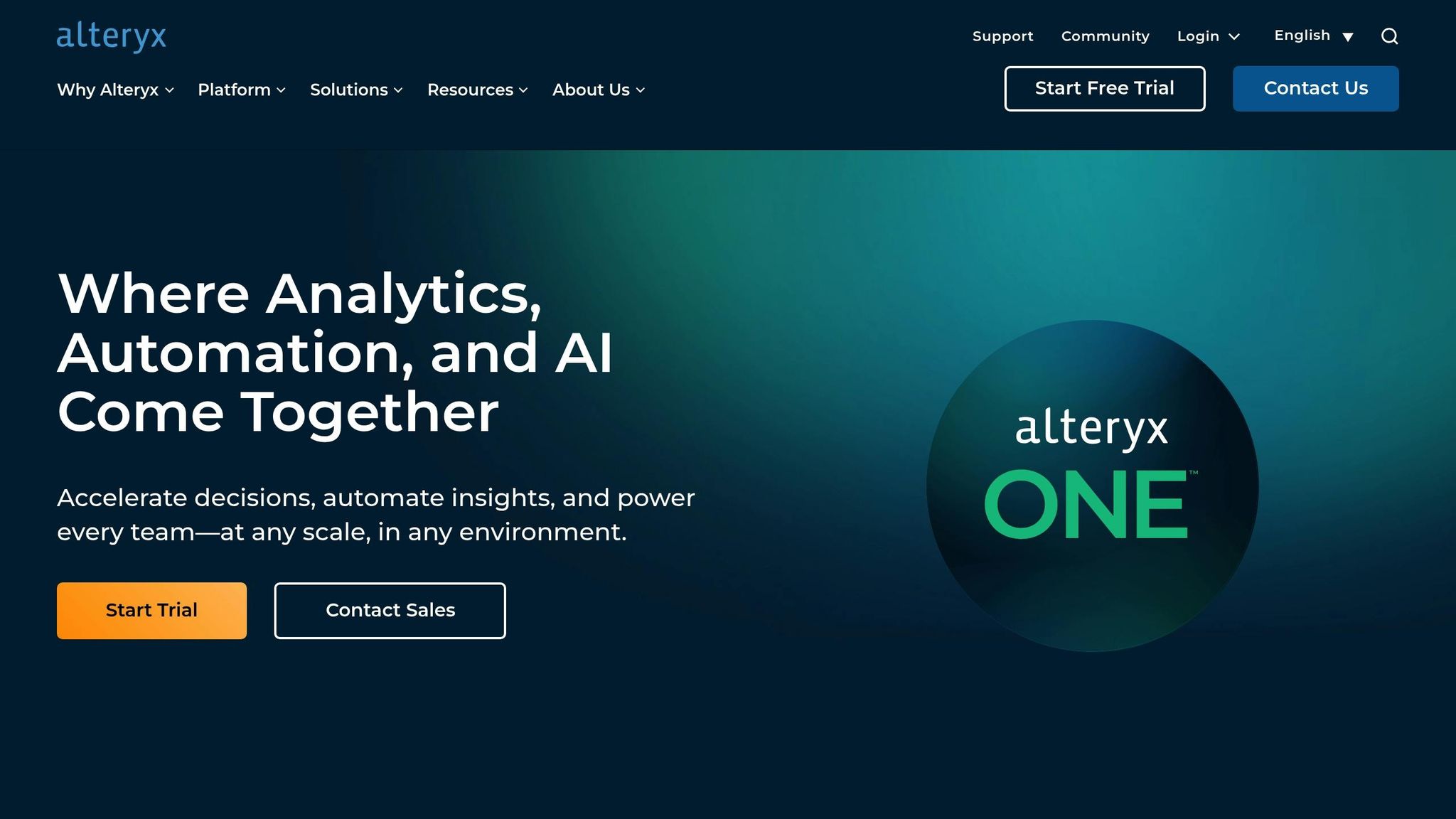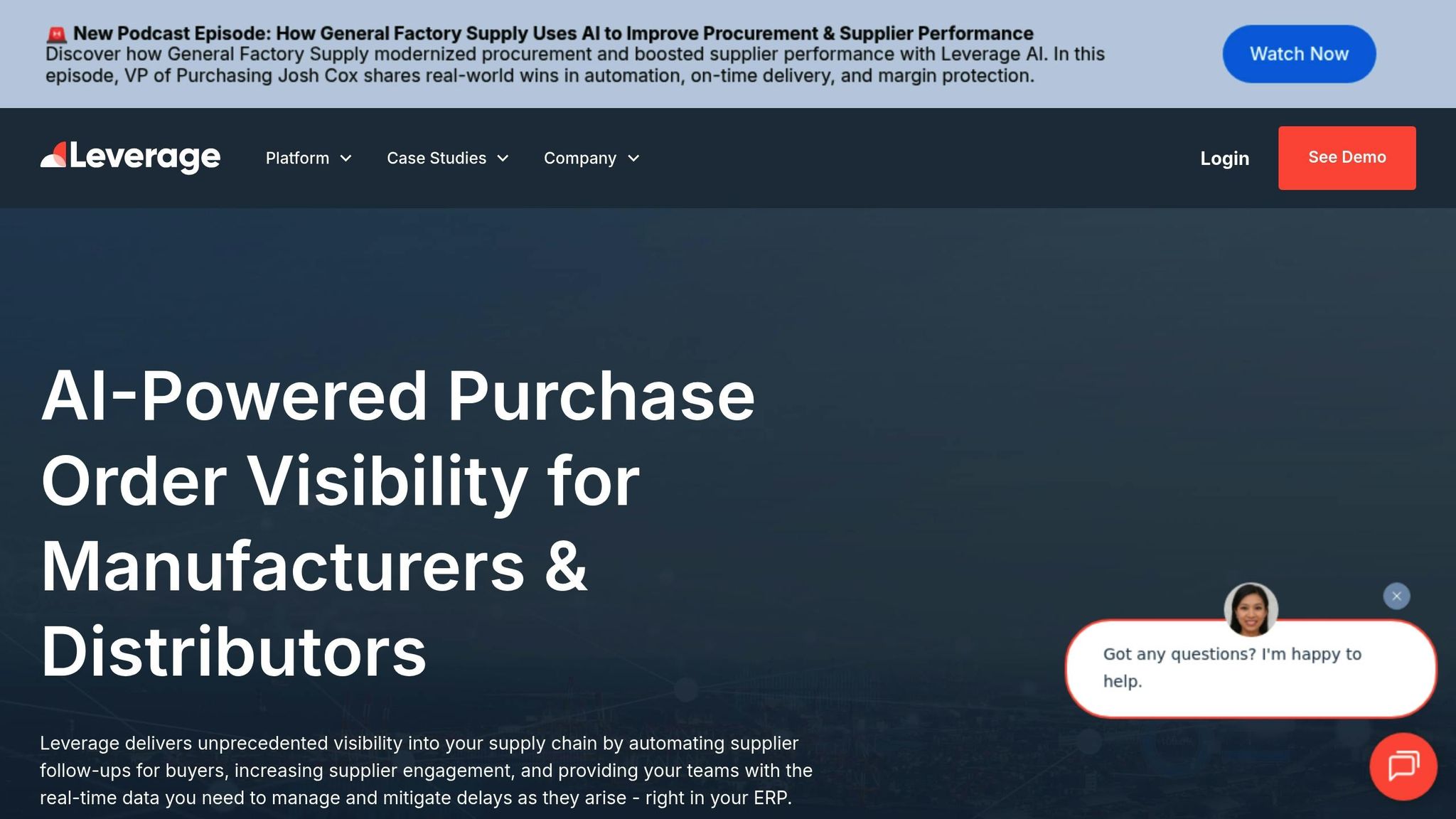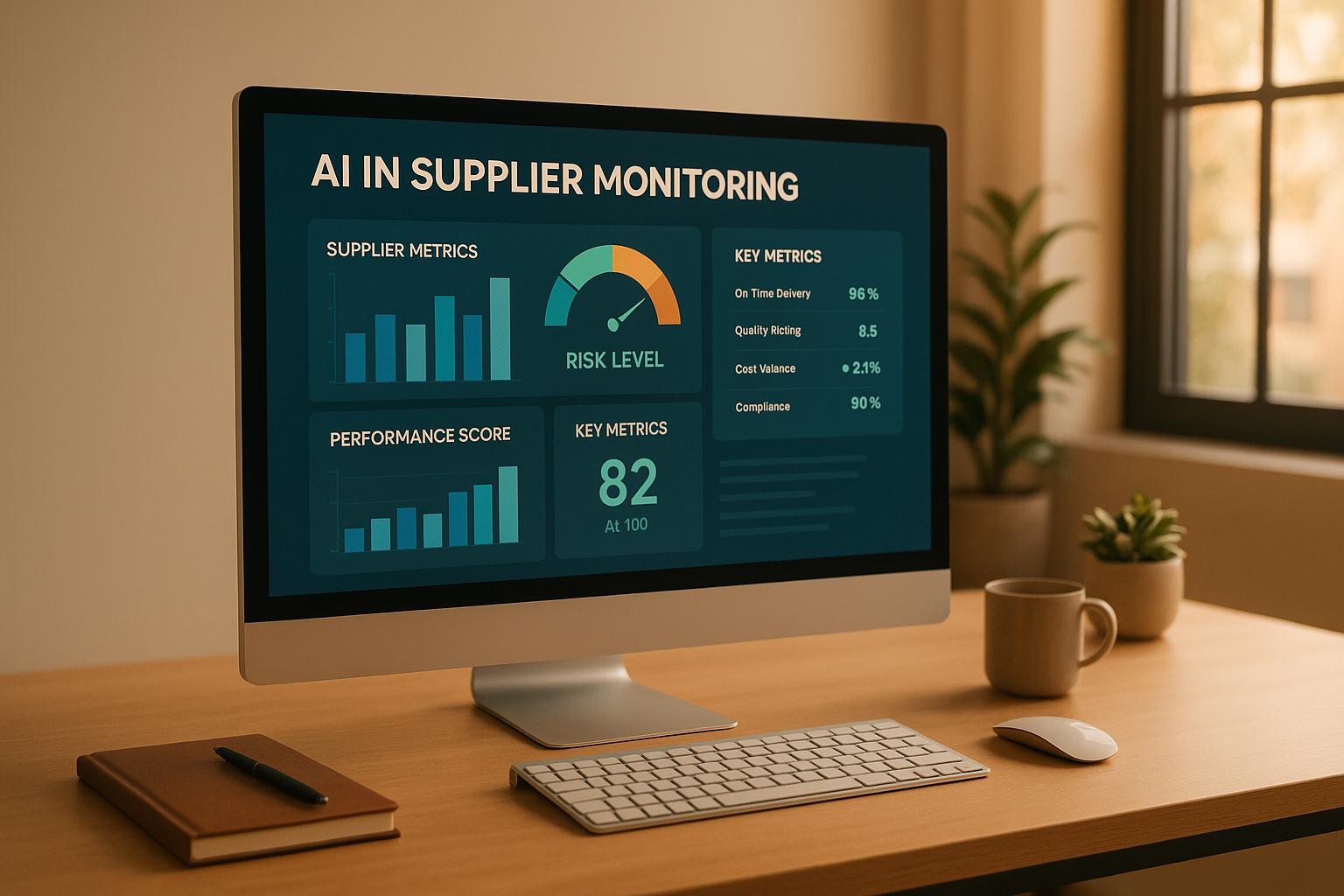AI-Powered Supplier KPI Tracking: Key Benefits
%202%20(1).png?width=50&height=50&name=20250501_1415_Professional%20LinkedIn%20Update_remix_01jt6gxkjmekavnvzsewk61z9w%20(1)%202%20(1).png)
AI-powered tools are transforming how businesses track supplier KPIs. Compared to manual methods, these systems save time, reduce errors, and provide real-time insights. Here's what you need to know:
- Automation: AI eliminates manual data entry and updates KPIs in real time, improving accuracy and efficiency.
- Real-Time Insights: Platforms like Leverage AI provide live updates on supplier performance, enabling quicker, informed decisions.
- Predictive Analysis: Machine learning forecasts issues like delays or quality problems, helping businesses act before disruptions occur.
- Streamlined Communication: Automated follow-ups and centralized records keep supplier interactions organized and consistent.
- Cost Savings: By reducing labor-intensive tasks, AI frees up procurement teams to focus on supplier development and cost negotiations.
Quick Comparison:
| Feature | AI-Powered Tools | Manual Methods |
|---|---|---|
| Accuracy | Automated, error-free data | Prone to human errors |
| Insights | Real-time, actionable | Delayed, limited |
| Predictive Capabilities | Advanced forecasting | Minimal |
| Supplier Communication | Centralized, automated | Scattered, manual follow-ups |
| Cost Efficiency | Labor-saving, data-driven | High labor costs, inefficient |
Switching to AI-driven KPI tracking not only improves efficiency but also strengthens supplier relationships and reduces costs. For businesses managing complex supply chains, adopting AI solutions is a clear step forward.
Smarter Supplier Management with AI: See Alteryx in Action

1. Leverage AI

AI-powered supplier KPI tracking is reshaping how businesses monitor and enhance supply chain performance. Leverage AI offers a platform that connects seamlessly with ERP systems to automate supplier follow-ups, provide real-time visibility, and track performance intelligently. The result? Actionable insights that businesses can use to stay ahead.
Accuracy and Real-Time Insights
Traditional supplier KPI tracking often relies on spreadsheets and manual data entry, which can lead to errors and outdated information. Leverage AI eliminates these issues by pulling data directly from ERP systems. This automation reduces transcription errors and ensures up-to-date information.
The platform’s AI document parsing feature extracts critical details from supplier communications, purchase orders, and delivery confirmations. This removes the need for manual data entry while ensuring every supplier interaction is systematically tracked. Real-time updates to KPIs - such as on-time delivery rates, quality metrics, and lead times - keep businesses in the loop at all times.
Supplier scorecards offer a centralized view of each supplier’s performance across various metrics. These scorecards automatically calculate performance ratings using delivery data, quality reports, and responsiveness metrics. This real-time scoring helps procurement teams spot trends and address issues as they arise, rather than weeks or months later.
Predictive Capabilities
The platform doesn’t stop at real-time tracking; it also predicts future challenges. By analyzing supplier behavior, seasonal trends, and external factors, Leverage AI forecasts potential delivery delays or quality issues before they disrupt operations.
Machine learning algorithms identify early warning signs, like increasing lead times or slower supplier responses. These insights allow procurement teams to take proactive steps, such as adjusting schedules or lining up alternative suppliers.
Historical performance data is also put to good use. The platform analyzes which suppliers consistently deliver during peak periods or tough market conditions, helping businesses make smarter decisions about supplier allocation and contract negotiations.
Supplier Engagement and Collaboration
Tracking KPIs effectively requires ongoing communication between buyers and suppliers. Leverage AI simplifies this with email-based smart POs that automatically send purchase orders and follow-up requests through email. This approach ensures smooth communication while keeping a detailed record of all interactions.
The platform’s automated follow-up system ensures critical milestones - like order acknowledgments and shipping notifications - are consistently tracked. Automatic reminders and escalation protocols ensure suppliers stay on schedule.
Customizable workflows let businesses tailor engagement processes to fit their needs. Communication frequency and requirements can be adjusted based on factors like supplier performance history, order complexity, or strategic importance.
Cost Optimization
AI-powered supplier KPI tracking doesn’t just improve efficiency - it also saves money. By automating routine tasks like follow-ups and data collection, the platform frees up procurement teams to focus on strategic priorities like supplier development and contract negotiations, rather than chasing status updates.
Detailed performance tracking also strengthens supplier negotiations. Procurement teams can use objective data to secure better terms with reliable suppliers or address issues with underperformers. This data-driven approach typically leads to better pricing, improved service, and reduced risks throughout the supply chain.
To top it off, the expert support team is available to help businesses maximize the platform’s benefits without needing extra internal technical resources.
2. Manual Supplier KPI Tracking
Manual KPI tracking, while still widely used, often lacks the precision and adaptability of AI-powered systems. It can slow decision-making, drive up costs, and struggle to keep pace with the growing complexity of supply chains. Many organizations still rely on traditional methods like spreadsheets, email chains, and manual data collection. While these approaches have stood the test of time, their limitations become glaringly obvious as supply chains expand and demand greater efficiency.
Accuracy and Real-Time Insights
Manual tracking involves pulling data from multiple sources and compiling it into spreadsheets - a process that’s highly prone to human error. Simple mistakes, like typos or miscalculated formulas, can throw off supplier performance metrics.
Another major issue is version control. When different team members work on various versions of a spreadsheet, it’s easy for reports to conflict, leaving decision-makers unsure which data to trust. On top of that, manual systems often lag behind real-time performance. By the time procurement teams notice a supplier's performance is slipping, the damage may already be done.
Predictive Capabilities
Manual methods are good at recording past events but fall short when it comes to predicting future trends. For instance, a procurement professional might notice that a supplier is frequently late, but spotting more subtle patterns - like seasonal delays or capacity constraints - requires intensive analysis. Most teams simply don’t have the time or resources to dig that deep.
Without predictive insights, procurement teams are left relying on gut instincts or basic historical averages when making decisions. This reactive approach often means missed opportunities to address issues before they escalate into full-blown disruptions.
Supplier Engagement and Collaboration
In manual systems, supplier communication is often scattered across email threads, phone calls, and occasional meetings. Keeping track of these interactions requires diligent record-keeping, which can easily fall through the cracks during busy periods.
Follow-ups, such as checking on order acknowledgments or shipping confirmations, rely entirely on team members remembering to act. Without automated reminders, important tasks can slip, leading to misaligned expectations and frustrated suppliers.
When documentation is scattered or incomplete, critical supplier context can be lost. If a team member leaves or changes roles, their knowledge about supplier relationships often leaves with them. This lack of continuity makes it harder for new team members to manage relationships effectively, potentially straining long-standing partnerships and adding unnecessary costs.
Cost Optimization
Manual tracking eats up valuable time that procurement professionals could spend on more strategic activities. Hours are wasted updating spreadsheets, chasing down status updates, and reconciling conflicting data instead of focusing on supplier development or cost-saving initiatives.
Labor costs also balloon when multiple team members duplicate efforts or spend time fixing errors. Senior procurement staff, who should be driving value through strategic partnerships, often find themselves bogged down in administrative tasks like data entry and report creation.
The absence of detailed performance data weakens procurement teams’ ability to negotiate better terms with suppliers. Without objective metrics, it’s harder to justify requests for lower prices or improved service levels. This puts the team at a disadvantage, potentially locking them into higher costs or less favorable contract terms for years.
Mistakes in manual tracking can also lead to costly errors. For example, overstocking due to incorrect lead time data or missing delivery deadlines because of poor performance tracking can cost thousands of dollars per incident. Beyond the financial impact, these errors can damage customer relationships, creating ripple effects throughout the business.
sbb-itb-b077dd9
Pros and Cons
When comparing AI-powered supplier KPI tracking with manual methods, the differences are clear in several key areas, each playing a crucial role in procurement operations.
AI-powered tools, such as Leverage AI, bring automation, precision, and real-time insights to the table, drastically cutting down on data errors. These tools help procurement teams address potential issues before they escalate, thanks to their data-driven insights. However, adopting AI solutions does come with upfront costs and a learning curve, especially for teams used to traditional methods. On the other hand, manual processes, while familiar and requiring no specialized software, often lack the advanced analytics and efficiency needed for today’s complex supply chains. Below is a detailed comparison.
| Criteria | AI-Powered Solutions (e.g., Leverage AI) | Manual Approaches |
|---|---|---|
| Accuracy and Real-Time Insights | Automated data collection minimizes human error; real-time dashboards provide instant visibility into supplier performance; ensures consistent reporting across teams. | Susceptible to data entry errors and version control problems; delayed reporting can lead to late issue detection; multiple spreadsheet versions can cause confusion. |
| Data-Driven Insights | Advanced analytics offer actionable insights in real time; centralized dashboards allow teams to spot trends and adjust strategies quickly. | Relies on historical data, limiting the ability to identify emerging trends promptly; manual interpretation is time-consuming and less reliable. |
| Supplier Engagement and Collaboration | Automated follow-ups ensure consistent communication; centralized platforms maintain complete interaction histories; streamlined workflows improve response times. | Communication often scattered across various emails and calls; manual follow-ups may be overlooked during busy periods; knowledge gaps can emerge when team members leave. |
| Cost Optimization | Automation reduces staff workload, allowing focus on strategic tasks; detailed performance data strengthens negotiation positions and prevents costly errors. | High labor costs for manual data management; limited insights weaken negotiation leverage; errors in manual tracking can lead to expensive mistakes. |
The choice between these approaches depends on the scale and complexity of your supply chain. Large, intricate networks benefit greatly from the efficiency and precision of AI-powered systems, while smaller operations might initially stick to manual tracking. That said, even smaller companies managing global supply chains often find AI solutions to be a game-changer, enhancing both efficiency and supplier relationships.
Shifting from manual tracking to AI is more than just adopting new technology - it’s about embracing a data-driven approach that can redefine procurement operations.
Conclusion
Switching from manual tracking to AI-powered solutions is reshaping supply chain management. These advanced platforms bring noticeable improvements in accuracy, efficiency, and supplier relationships, all while cutting operational costs and reducing risks.
The comparison is clear: AI-driven tools offer better precision, faster processes, and the ability to address issues before they escalate. Real-time visibility eliminates delays, and automation reduces human error, allowing teams to focus on solving potential problems proactively. These enhancements lead to stronger supplier partnerships, better negotiation leverage, and more resilient supply chains, making a strong case for rapid adoption.
For manufacturers and distributors navigating today’s global markets, the real question isn’t if AI-powered supplier KPI tracking should be adopted - it’s how soon. The competitive edge provided by improved supplier monitoring, automated follow-ups, and data-driven decisions becomes even more critical as supply chains grow more complex.
Leverage AI offers a robust solution to address the challenges of manual tracking. Features like seamless ERP integration, automated purchase order management, and real-time supplier scorecards revolutionize procurement processes. Customizable workflows and dedicated support ensure the technology adapts to your organization’s needs without disrupting current operations.
By adopting AI-powered KPI tracking, businesses can lower labor costs, enhance supplier compliance, and reduce risks. Companies embracing this technology are better equipped to build strategic supplier relationships, optimize procurement strategies, and maintain a competitive edge in an increasingly demanding marketplace.
For procurement teams ready to move beyond spreadsheets, exploring Leverage AI could be the next step toward achieving operational excellence.
FAQs
How does AI improve supplier KPI tracking and decision-making compared to manual methods?
AI-driven supplier KPI tracking is changing the game for decision-making by providing real-time, precise, and forward-looking insights. Traditional manual tracking methods, which depend on periodic updates and are vulnerable to human error, simply can’t keep up. AI, on the other hand, keeps a constant eye on key metrics like delivery performance and quality scores, enabling quicker, smarter decisions to tackle issues before they escalate.
By automating the process of collecting and analyzing data, AI eliminates inefficiencies and strengthens supply chain reliability. This not only leads to better supplier relationships and cost management but also boosts overall operational performance - making it an indispensable asset for today’s supply chain strategies.
How does AI help predict and prevent supplier-related disruptions in the supply chain?
AI brings a new level of precision to supplier KPI tracking by leveraging predictive tools that process both past and real-time data. This allows businesses to anticipate demand, spot possible delays, and foresee supply chain hiccups before they escalate into bigger problems.
By tackling risks early, companies can fine-tune inventory levels, boost supplier performance, and ensure operations run more smoothly. The result? Fewer costly disruptions and a stronger, more reliable supply chain.
How does AI-powered KPI tracking help businesses save money?
AI-powered KPI tracking can be a game-changer for businesses looking to cut costs. By automating data collection and analysis, it eliminates the need for manual input, reducing labor expenses and minimizing the risk of expensive errors. This makes operations more efficient and less resource-intensive.
On top of that, AI offers real-time monitoring and predictive insights, which help businesses spot inefficiencies quickly. Whether it’s fine-tuning inventory management or streamlining logistics, these tools can lead to dramatic savings. In fact, businesses can see transportation and inventory costs drop by anywhere from 15% to 45%, creating lasting financial advantages.
%202%20(1).png?width=50&height=50&name=20250501_1415_Professional%20LinkedIn%20Update_remix_01jt6gxkjmekavnvzsewk61z9w%20(1)%202%20(1).png)

